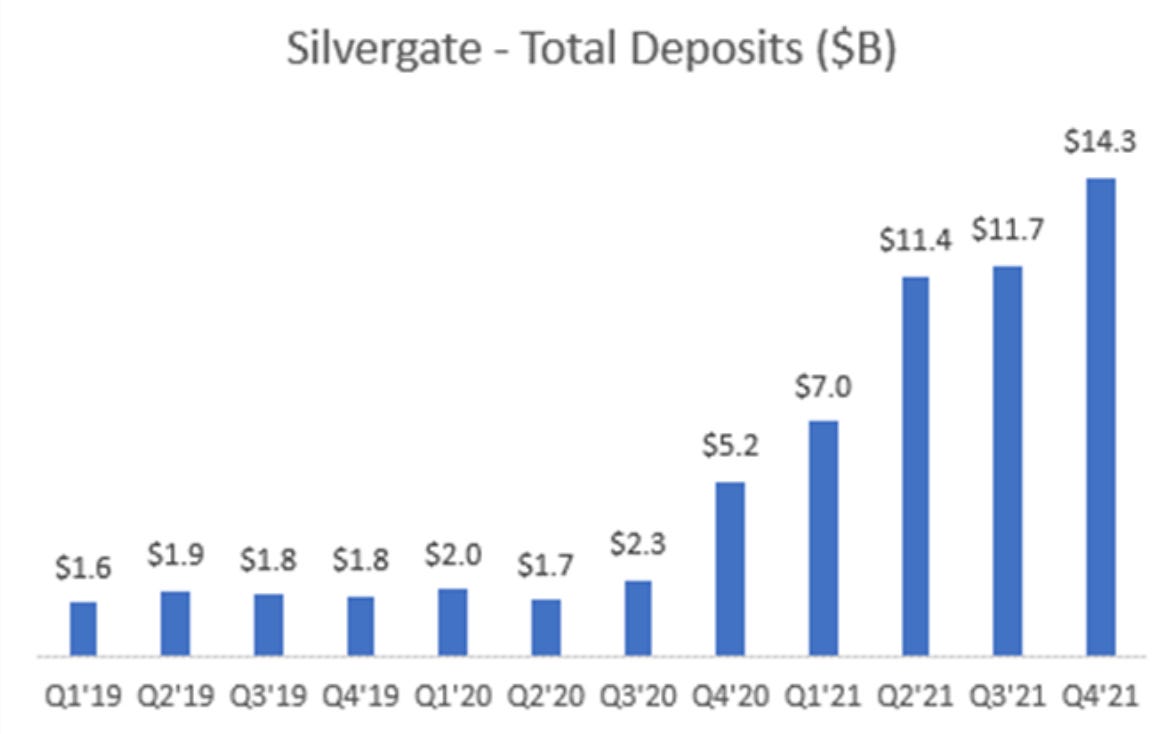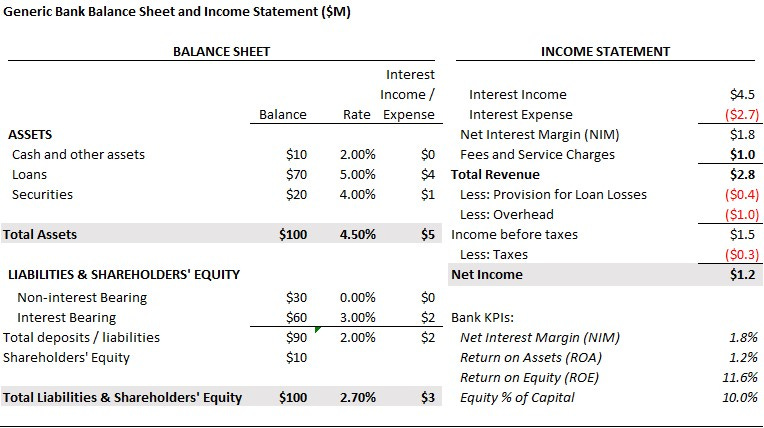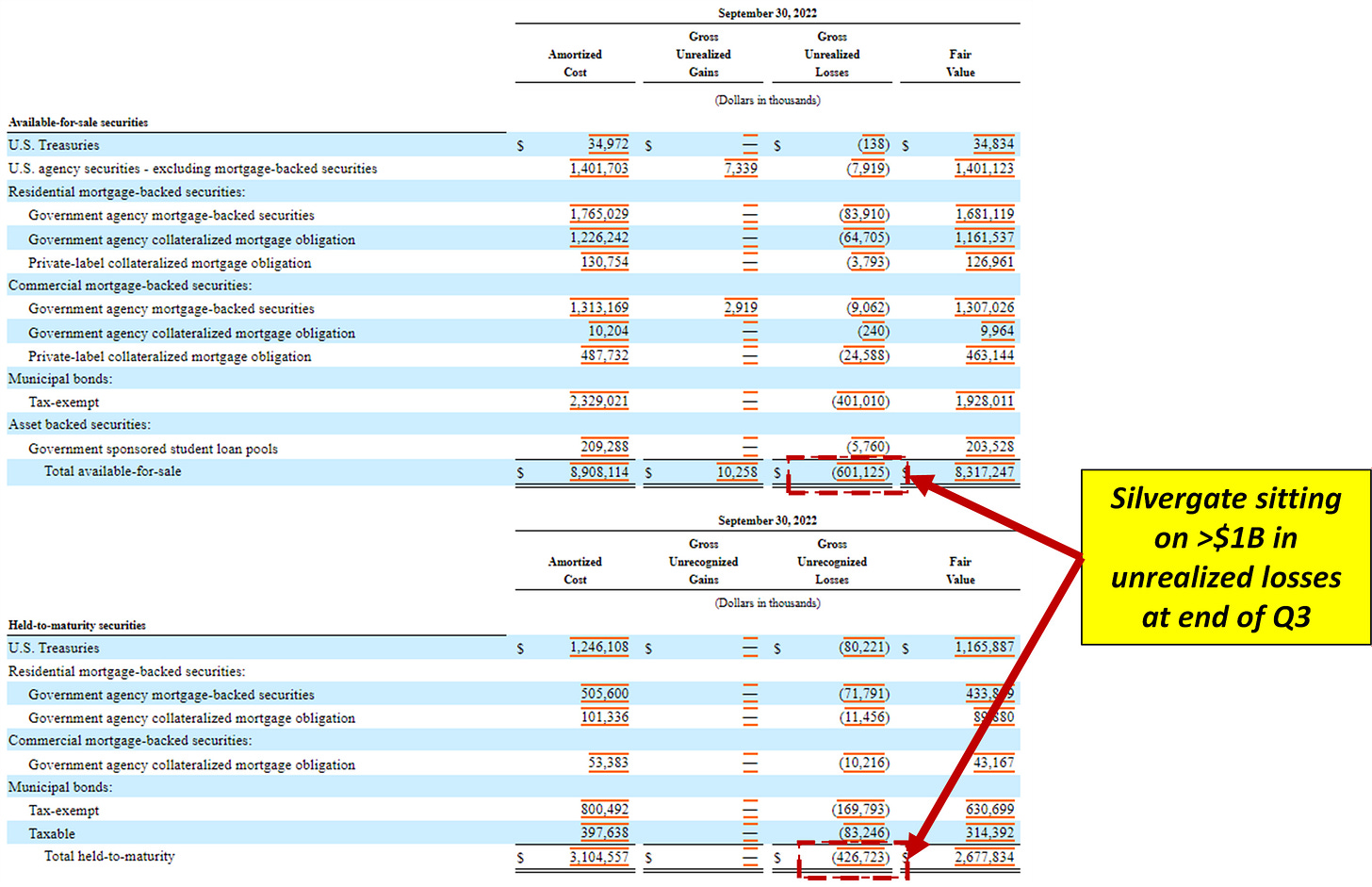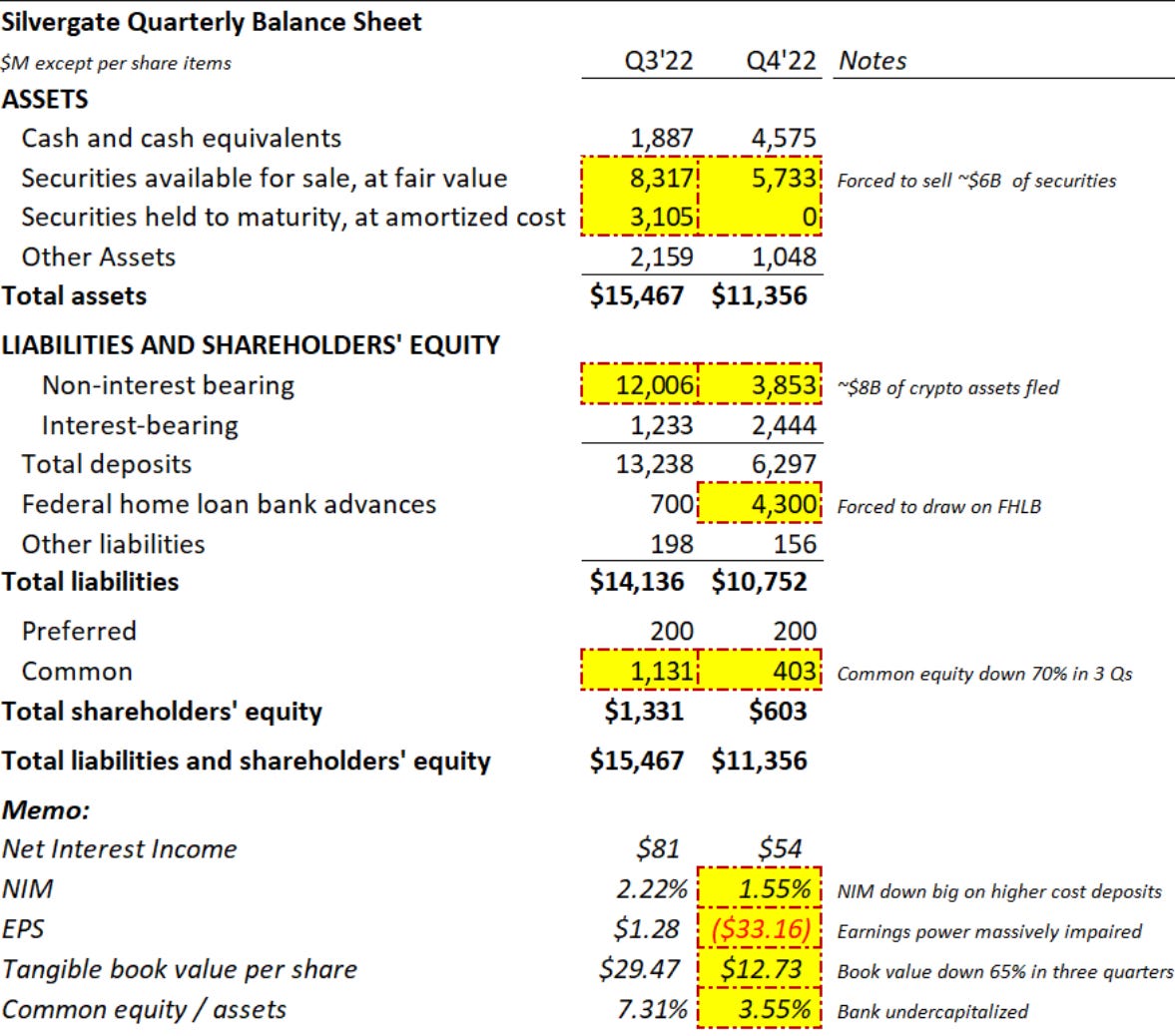Founded in 1986, Silvergate Capital Corp (ticker: SI, hereafter referred to as “Silvergate”) was for decades a sleepy La Jolla-based community bank. That all changed during the 2020 / 2021 crypto bull market.
Following Silvergate’s 2019 IPO, the bank’s deposits grew from $2 billion to $14 billion - 7x! - and the bank’s stock price increased an astounding 1600%, running from $13 to $220 per share.
But since peaking in November 2021, the stock is down 97% to $5 and the company is at risk of going under. A rapid fall from grace.
All of which begs the question:
WHAT THE HELL HAPPENED?
A story about how banks get rekt.
Silvergate Intro
Silvergate is a publicly-traded bank known for its leading crypto franchise. The company’s proprietary Silvergate Gate Exchange Network (SEN) is a technology platform used to connect more than 1,600 crypto exchanges, financial institutions, hedge funds, and retail participants. With 24/7 uptime and instant fiat transfers used to connect crypto market participants all over the world, SEN was the go-to bank for crypto fiat needs.
Silvergate’s SEN network enabled the bank’s incredible deposit growth, increasing 7x from ~$2 billion to a peak of $14 billion in Q4 2021. Both Silvergate and Signature Bank’s Signet saw massive growth as they were effectively the only two banks in the United States to onramp fiat into the global crypto ecosystem.
Ok this all sounds great: Silvergate crushed it during the bull market. So where did they go wrong?
First, let’s take a quick detour into how banks make money.
How Banks Make Money
(Skip this section if you’re familiar w/ bank business models)
At their most basic level, banks are simple businesses. They take in capital in the form of Equity + Liabilities (mostly deposits) and acquire Assets (e.g. make loans and buy securities).
Equity + Liabilities: Banks start with equity capital from a group of investors and take in deposits up to some multiple of the equity (around 10x; regulators place strict limits are how well capitalized financial institutions need to be). Banks attract deposits by offering services to retail and commercial clients, such as checking, savings, bill pay, loans, etc. Specialized banks such as Silvergate attract deposits with unique offerings such as the SEN network. Banks also attract deposits by paying for them, offering a yield on deposits. These are called Interest-bearing (IB) Deposits. IB deposits are considered lower-quality compared to Non-interest Bearing (NIB) Deposits. IB deposits are lower margin vs. NIB deposits and often more fickle as they will seek out the highest bidder.
Assets: With this pool of equity and deposit capital, banks make loans to businesses, real estate projects (e.g. mortgages), or consumers (e.g. auto loans) or they buy securities, such as treasury bonds, municipal bonds, mortgage-backed securities (MBS) or highly-rated corporate bonds. Banks typically avoid “risky” securities such as junk bonds and stocks. As a highly leveraged enterprise (i.e. 10-to-1 equity-to-capital), banks cannot afford serious losses on the asset side of their balance sheet. Asset losses at a minimum impair the bank’s equity capital and under a worst case scenario risk impairing depositor obligations.
Put depositor obligations at risk and banking regulators will shut you down real quick. Remember this for later…
The yield a bank earns on its assets minus the cost it pays for its deposits equals a bank’s Net Interest Margin, or NIM. Banks also earn revenue from other services such as wealth management or fees from underwriting. However, NIM is typically a bank’s largest revenue driver. Subtract overhead such as people costs and back out taxes and you get to a bank’s net income.
Below is a simple balance sheet and income statement for a $100 million asset bank. Note the biggest drivers of a bank’s earnings power are the size of its deposit franchise and its NIM, the spread it earns on asset yields minus deposit costs.
A bank with a rapidly growing and cheap deposit base is extremely valuable.
Silvergate fit this mold perfectly during the crypto upcycle. Crypto depositors flooded cash into the crypto ecosystem and were willing to hold their fiat with Silvergate at no cost in return for access to the bank’s proprietary SEN network. Significant growth in cheap deposits led SI’s earnings power and share price to skyrocket in 2020 and 2021:
How Banks Get Rekt: Credit Blow Ups and Duration Mismatch
Banks take in deposits and make loans and buy securities. It’s so simple… How can anyone mess this up?
Banks get into trouble when they impair the asset side of the balance sheet and are forced to take losses on shareholders’ equity. Excluding fraud, banks can do this in two ways: (1) Credit Blow Ups and (2) Duration Mismatch.
Credit Blow Ups: Banks can make bad loans or buy bad securities. In other words, acquire assets from bad counterparties that are unable to meet their obligations, resulting in losses. Steep loan and security losses created the Great Financial Crisis, forcing the Fed to bail out many large financial institutions or risk collapsing the global financial system. Shareholders of banks and financial institutions that held the worst loans and securities, such as Lehman Brothers, Countrywide, and Bear Stearns, got wiped out as the losses on the asset side of their balance sheets were far greater than the banks’ equity capital.
Duration Mismatch: Duration mismatch occurs when a bank is forced to sell assets at a loss in a fire sale in order to meet depositor redemptions during a bank run. Sell enough assets at a steep enough discount to price paid and a bank’s equity capital can disappear in the blink of an eye.
Duration mismatch during a bank run is what took down Silvergate in the wake of the FTX collapse.
How Silvergate Got Rekt: Forced to Sell Long Duration Assets at Huge Losses
As Silvergate’s balance sheet rapidly grew during the crypto bull market, the company acquired billions in long-duration municipal bonds and mortgage-backed securities (MBS). Unfortunately for Silvergate, interest rates increased rapidly throughout 2022, significantly reducing the value of Silvergate’s securities portfolio.
(see here for an overview of the relationship between interest rates and bond prices; TLDR long-duration bonds decrease in value when interest rates rise.)
As of the end of Q3 2022, Silvergate had over $1 billion in unrealized losses on its securities book. The bank clearly acquired long duration assets at an unfavorable time in history.
Source: SI Q3 10Q
But no matter, the losses are unrealized. As long as Silvergate depositors kept their money on the platform and Silvergate could hold its bonds to maturity, things would be fine... right?
Whoopsy.
In the wake of the FTX’s November 2022 bankruptcy, Silvergate depositors rushed to withdraw their funds in a panic. In Q4 2022, Silvergate deposits declined an incredible $8 billion, or down 68% in a single quarter. A textbook bank run.
To meet depositor redemptions Silvergate was forced to sell $6 billion of securities that it hard acquired over the past 1-2 years at a cost of ~$7 billion. As a result, the company realized roughly $900 million of securities losses, wiping out 70% of Silvergate’s common equity in the process.
The steep drawdown in deposits and $900 million in realized securities losses rekt Silvergate’s shareholders’ equity and earnings power:
The company also drew $4.3 billion on the emergency lending program of the Federal Home Loan Bank (FHLB). In addition to tapping an expensive source of financing, according to my conversations with industry insiders, Silvergate’s bank run displeased regulators. Putting customer deposits at risk is a major no-no with bank regulators.
The more recent revelations that Silvergate had to sell even more securities in Q1 and shut down its SEN network are likely signs that regulators are sadly putting an end to Silvergate’s crypto ambitions altogether.
Does Signature Bank Face Similar Risks? Unlikely.
Silvergate’s crypto banking peer Signature Bank (ticker: SBNY) is often rumored as the “next shoe to drop” in the crypto regulatory crackdown.
I believe a Silvergate-esque bank run and regulatory onslaught is unlikely for several reasons:
Signature Bank is significantly larger and far more diversified. As of the end of Q4, Signature had $110 billion in assets vs. Silvergate’s $11 billion (i.e. 10x larger). Only ~$18 billion, or 20%, of its $89 billion of deposits are tied to crypto. This compares to Silvergate’s deposit franchise which is effectively 100% crypto.
Signature’s balance sheet is far more liquid. Signature has $34 billion of liquid assets ($9 billion cash plus $26 billion of securities at fair value). This is almost 2x Signature’s $18 billion in crypto deposit exposure. In the event of a run on crypto deposits Signature would be able to meet redemptions with minimal securities losses.
Signature has a longer history with regulators. This is a bit more speculative, but I believe the bank won’t come under the same regulatory crackdown as Silvergate. As the company highlights in response to a WSJ article, Signature has a long history with the FHLB and regularly taps its lending services. This compares to Silvergate which utilized the FHLB in a panic.
Signature has ~20% Crypto Deposit Exposure and 2x the Liquidity of its Deposit Exposure
Source: SBNY earnings deck
Conclusion: Don’t Fund Long-duration Assets with Fickle Crypto Deposits
Had Silvergate used customer deposits to acquire cash and short-term treasuries and NOT long duration municipal bonds and mortgage-backed securities, Silvergate could have avoided this unfortunate outcome. The mismatch between highly fickle crypto deposits and long duration assets sensitive to interest rate movements caused Silvergate to realize massive losses. With cash and short-term treasuries, Silvergate could have met customer redemptions, avoided crippling equity impairments, and not tapped into the FHLB emergency lending program.
Notably, the risk of crypto deposit flight is exactly why USDC structures its reserves with extremely liquid 20% cash / 80% 3-month T bills. If you’re interested in learning about crypto’s #1 stablecoin, see my earlier article here:
If you’re in the market for a sick hat and love spreading aloha, check out Aloha Lidz.
Writing takes an immense amount of time and effort. You can further support my work by:
(For traders) Using my ref link for 10% off trades on GMX, crypto’s #1 trading platform: http://app.gmx.io/?ref=808trades
(For everyone else): Making a smol donation via my ETH wallet: 0x8Ab68C848749956e9F26d8a76C1FCB60817366c1











What is the reason that Silvergate draws $4300M from FHLB while, at the same time, it has $4575M in cash and cash equivalent? Why doesn't it simply pay off its FHLB loan with its cash? This way, Silvergate could reduce its asset side by 38% and would have a Common equity /assets ratio of 5.7% instead of 3.55%.